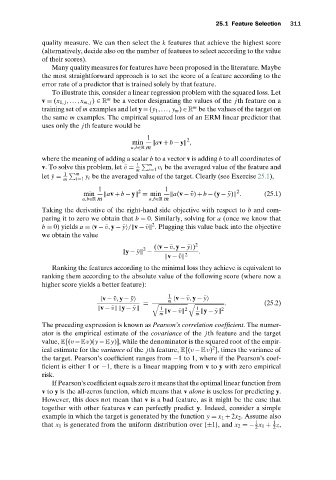Page 329 - Understanding Machine Learning
P. 329
25.1 Feature Selection 311
quality measure. We can then select the k features that achieve the highest score
(alternatively, decide also on the number of features to select according to the value
of their scores).
Many quality measures for features have been proposed in the literature. Maybe
the most straightforward approach is to set the score of a feature according to the
error rate of a predictor that is trained solely by that feature.
To illustrate this, consider a linear regression problem with the squared loss. Let
m
v = ( x 1, j ,..., x m, j ) ∈ R be a vector designating the values of the jth feature on a
m
training set of m examples and let y = ( y 1 ,..., y m ) ∈ R be the values of the target on
the same m examples. The empirical squared loss of an ERM linear predictor that
uses only the jth feature would be
1 2
min av + b − y ,
a,b∈R m
where the meaning of adding a scalar b to a vector v is adding b to all coordinates of
1 m
v
v. To solve this problem, let ¯v = i=1 i be the averaged value of the feature and
m
1 m
y
let ¯y = i=1 i be the averaged value of the target. Clearly (see Exercise 25.1),
m
1 2 1 2
min av + b − y = min a(v −¯v) + b − (y −¯y) . (25.1)
a,b∈R m a,b∈R m
Taking the derivative of the right-hand side objective with respect to b and com-
paring it to zero we obtain that b = 0. Similarly, solving for a (once we know that
2
b = 0) yields a = v −¯v,y −¯y / v −¯v . Plugging this value back into the objective
we obtain the value
( v −¯v,y −¯y ) 2
2
y −¯y − 2 .
v −¯v
Ranking the features according to the minimal loss they achieve is equivalent to
ranking them according to the absolute value of the following score (where now a
higher score yields a better feature):
1
v −¯v,y −¯y v −¯v,y −¯y
m
= . (25.2)
v −¯v y −¯y 1 2 1 2
m v −¯v m y −¯y
The preceding expression is known as Pearson’s correlation coefficient. The numer-
ator is the empirical estimate of the covariance of the jth feature and the target
value, E[(v −Ev)(y −E y)], while the denominator is the squared root of the empir-
2
ical estimate for the variance of the jth feature, E[(v − Ev) ], times the variance of
the target. Pearson’s coefficient ranges from −1 to 1, where if the Pearson’s coef-
ficient is either 1 or −1, there is a linear mapping from v to y with zero empirical
risk.
If Pearson’s coefficient equals zero it means that the optimal linear function from
v to y is the all-zeros function, which means that v alone is useless for predicting y.
However, this does not mean that v is a bad feature, as it might be the case that
together with other features v can perfectly predict y. Indeed, consider a simple
example in which the target is generated by the function y = x 1 + 2x 2 . Assume also
1
1
that x 1 is generated from the uniform distribution over {±1},and x 2 =− x 1 + z,
2 2

